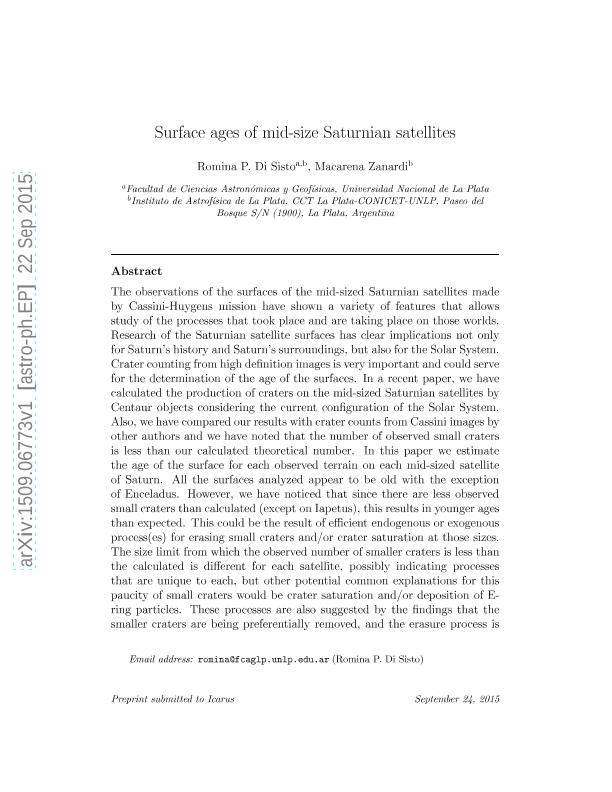Mostrar el registro sencillo del ítem
dc.contributor.author
Di Sisto, Romina Paula

dc.contributor.author
Zanardi, Macarena

dc.date.available
2018-02-02T17:48:04Z
dc.date.issued
2016-01
dc.identifier.citation
Di Sisto, Romina Paula; Zanardi, Macarena; Surface ages of mid-size Saturnian satellites; Academic Press Inc Elsevier Science; Icarus; 264; -; 1-2016; 90-101
dc.identifier.issn
0019-1035
dc.identifier.uri
http://hdl.handle.net/11336/35509
dc.description.abstract
The observations of the surfaces of the mid-sized saturnian satellites made by Cassini–Huygens mission have shown a variety of features that allows study of the processes that took place and are taking place on those worlds. Research of the saturnian satellite surfaces has clear implications not only for Saturn’s history and Saturn’s surroundings, but also for the Solar System. Crater counting from high definition images is very important and could serve for the determination of the age of the surfaces. In a recent paper, we have calculated the production of craters on the mid-sized saturnian satellites by Centaur objects considering the current configuration of the Solar System. Also, we have compared our results with crater counts from Cassini images by other authors and we have noted that the number of observed small craters is less than our calculated theoretical number. In this paper we estimate the age of the surface for each observed terrain on each mid-sized satellite of Saturn. All the surfaces analyzed appear to be old with the exception of Enceladus. However, we have noticed that since there are less observed small craters than calculated (except on Iapetus), this results in younger ages than expected. This could be the result of efficient endogenous or exogenous process(es) for erasing small craters and/or crater saturation at those sizes. The size limit from which the observed number of smaller craters is less than the calculated is different for each satellite, possibly indicating processes that are unique to each, but other potential common explanations for this paucity of small craters would be crater saturation and/or deposition of E-ring particles. These processes are also suggested by the findings that the smaller craters are being preferentially removed, and the erasure process is gradual. On Enceladus, only mid and high latitude plains have remnants of old terrains; the other regions could be young. In particular, the regions near the South Polar Terrain could be as young as 50 Myr old. On the contrary for Iapetus, all the surface is old and it notably registers a primordial source of craters. As the crater size is decreased, it would be perceived to approach saturation until DK 2 km-craters, where saturation is complete.
dc.format
application/pdf
dc.language.iso
eng
dc.publisher
Academic Press Inc Elsevier Science

dc.rights
info:eu-repo/semantics/openAccess
dc.rights.uri
https://creativecommons.org/licenses/by-nc-sa/2.5/ar/
dc.subject
Saturn
dc.subject
Cratering
dc.subject
Centaurs
dc.subject
Stellites
dc.subject.classification
Astronomía

dc.subject.classification
Ciencias Físicas

dc.subject.classification
CIENCIAS NATURALES Y EXACTAS

dc.title
Surface ages of mid-size Saturnian satellites
dc.type
info:eu-repo/semantics/article
dc.type
info:ar-repo/semantics/artículo
dc.type
info:eu-repo/semantics/publishedVersion
dc.date.updated
2018-01-12T19:24:45Z
dc.journal.volume
264
dc.journal.number
-
dc.journal.pagination
90-101
dc.journal.pais
Estados Unidos

dc.journal.ciudad
Amsterdam
dc.description.fil
Fil: Di Sisto, Romina Paula. Consejo Nacional de Investigaciones Científicas y Técnicas. Centro Científico Tecnológico Conicet - La Plata. Instituto de Astrofísica La Plata. Universidad Nacional de La Plata. Facultad de Ciencias Astronómicas y Geofísicas. Instituto de Astrofísica la Plata; Argentina. Universidad Nacional de la Plata. Facultad de Ciencias Astronómicas y Geofísicas; Argentina
dc.description.fil
Fil: Zanardi, Macarena. Consejo Nacional de Investigaciones Científicas y Técnicas. Centro Científico Tecnológico Conicet - La Plata. Instituto de Astrofísica La Plata. Universidad Nacional de La Plata. Facultad de Ciencias Astronómicas y Geofísicas. Instituto de Astrofísica la Plata; Argentina
dc.journal.title
Icarus

dc.relation.alternativeid
info:eu-repo/semantics/altIdentifier/doi/http://dx.doi.org/10.1016/j.icarus.2015.09.012
dc.relation.alternativeid
info:eu-repo/semantics/altIdentifier/url/https://www.sciencedirect.com/science/article/pii/S0019103515004157?via%3Dihub
Archivos asociados
